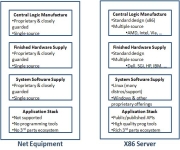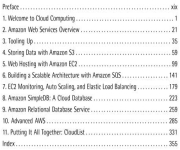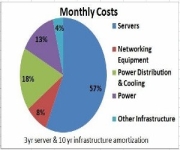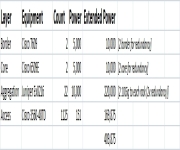Author Archive
Earlier this week Clay Magouyrk sent me a pointer to some very interesting work: A Couple More Nails in the Coffin of the Private Compute Cluster: Benchmarks for the Brand New Cluster GPU Instance on Amazon EC2. This detailed article has detailed benchmark results from runs on the new Cluster GPU Instance type and leads…
A year and half ago, I did a blog post titled heterogeneous computing using GPGPUs and FPGA. In that note I defined heterogeneous processing as the application of processors with different instruction set architectures (ISA) under direct application programmer control and pointed out that this really isn’t all that new a concept. We have had…
The Top 500 Super Computer Sites list was just updated and AWS Compute Cluster is now officially in the top half of the list. That means when you line up all the fastest, multi-million dollar, government lab sponsored super computers from #1 through to #500, the AWS Compute Cluster Instance is at #231: Position…
Kushagra Vaid presented at Datacenter Power Efficiency at Hotpower ’10. The URL to the slides is below and my notes follow. Interesting across the board but most notable for all the detail on the four major Microsoft datacenters: · Services speeds and feeds: o Windows LiveID: More than 1B authentications/day o Exchange Hosted Services: 2…

I did a talk earlier this week on the sea change currently taking place in datacenter networks. In Datacenter Networks are in my Way I start with an overview of where the costs are in a high scale datacenter. With that backdrop, we note that networks are fairly low power consumers relative to the total…
What happens when you really, really, focus on efficient infrastructure and driving down costs while delivering a highly available, high performance service? Well, it works. Costs really do fall and the savings can be passed on to customers. AWS prices have been falling for years but this is different. Its now possible to offer an…

Long time Amazon Web Services Alum Jeff Barr has written a book on AWS. Jeff’s been with AWS since the very early days and he knows the services well. The new book Host Your Web Site in the Cloud: Amazon Web Services Made Easy, covers each of the major AWS services, how to write code…
This morning I came across an article written by Sid Anand, an architect at Netflix that is super interesting. I liked it for two reasons: 1) it talks about the move of substantial portions of a high-scale web site to the cloud, some of how it was done, and why it was done, and 2)…
Hosting multiple MySQL engines with MySQL Replication between them is a common design pattern for scaling read-heavy MySQL workloads. As with all scaling techniques, there are workloads for which it works very well but there are also potential issues that need to be understood. In this case, all write traffic is directed to the primary…

A couple of years ago, I did a detailed look at where the costs are in a modern , high-scale data center. The primary motivation behind bringing all the costs together was to understand where the problems are and find those easiest to address. Predictably, when I first brought these numbers together, a few data…
For those of you writing about your work on high scale cloud computing (and for those interested in a great excuse to visit Anchorage Alaska), consider submitting a paper to the Workshop on Data Intensive Cloud Computing in the Clouds (DataCloud 2011). The call for papers is below. –jrh ——————————————————————————————- *** Call for Papers ***…
I’m dragging myself off the floor as I write this having watched this short video: MongoDB is Web Scale. It won’t improve your datacenter PUE, your servers won’t get more efficient, and it won’t help you scale your databases but, still, you just have to check out that video. Thanks to Andrew Certain of Amazon…

You can now run an EC2 instance 24×7 for under $15/month with the announcement last night of the Micro instance type. The Micro includes 613 MB of RAM and can burst for short periods up to 2 EC2 Compute Units(One EC2 Compute Unit equals 1.0-1.2 GHz 2007 Opteron or 2007 Xeon processor). They are available…
I’m taking some time off and probably won’t blog again until the first week of September. Jennifer and I are taking the boat north to Alaska. Most summers we spend a bit of time between the northern tip of Vancouver island and the Alaska border. This year is a little different for 2 reasons. First,…

A couple of weeks back Greg Linden sent me an interesting paper called Energy Proportional Datacenter Networks. The principal of energy proportionality was first coined by Luiz Barroso and Urs Hölzle in an excellent paper titled The Case for Energy-Proportional Computing. The core principal behind energy proportionality is that computing equipment should consume power in…

High Performance Computing (HPC) is defined by Wikipedia as: High-performance computing (HPC) uses supercomputers and computer clusters to solve advanced computation problems. Today, computer systems approaching the teraflops-region are counted as HPC-computers. The term is most commonly associated with computing used for scientific research or computational science. A related term, high-performance technical computing (HPTC), generally…
Earlier this week Clay Magouyrk sent me a pointer to some very interesting work: A Couple More Nails in the Coffin of the Private Compute Cluster: Benchmarks for the Brand New Cluster GPU Instance on Amazon EC2. This detailed article has detailed benchmark results from runs on the new Cluster GPU Instance type and leads…
A year and half ago, I did a blog post titled heterogeneous computing using GPGPUs and FPGA. In that note I defined heterogeneous processing as the application of processors with different instruction set architectures (ISA) under direct application programmer control and pointed out that this really isn’t all that new a concept. We have had…
The Top 500 Super Computer Sites list was just updated and AWS Compute Cluster is now officially in the top half of the list. That means when you line up all the fastest, multi-million dollar, government lab sponsored super computers from #1 through to #500, the AWS Compute Cluster Instance is at #231: Position…
Kushagra Vaid presented at Datacenter Power Efficiency at Hotpower ’10. The URL to the slides is below and my notes follow. Interesting across the board but most notable for all the detail on the four major Microsoft datacenters: · Services speeds and feeds: o Windows LiveID: More than 1B authentications/day o Exchange Hosted Services: 2…

I did a talk earlier this week on the sea change currently taking place in datacenter networks. In Datacenter Networks are in my Way I start with an overview of where the costs are in a high scale datacenter. With that backdrop, we note that networks are fairly low power consumers relative to the total…
What happens when you really, really, focus on efficient infrastructure and driving down costs while delivering a highly available, high performance service? Well, it works. Costs really do fall and the savings can be passed on to customers. AWS prices have been falling for years but this is different. Its now possible to offer an…

Long time Amazon Web Services Alum Jeff Barr has written a book on AWS. Jeff’s been with AWS since the very early days and he knows the services well. The new book Host Your Web Site in the Cloud: Amazon Web Services Made Easy, covers each of the major AWS services, how to write code…
This morning I came across an article written by Sid Anand, an architect at Netflix that is super interesting. I liked it for two reasons: 1) it talks about the move of substantial portions of a high-scale web site to the cloud, some of how it was done, and why it was done, and 2)…
Hosting multiple MySQL engines with MySQL Replication between them is a common design pattern for scaling read-heavy MySQL workloads. As with all scaling techniques, there are workloads for which it works very well but there are also potential issues that need to be understood. In this case, all write traffic is directed to the primary…

A couple of years ago, I did a detailed look at where the costs are in a modern , high-scale data center. The primary motivation behind bringing all the costs together was to understand where the problems are and find those easiest to address. Predictably, when I first brought these numbers together, a few data…
For those of you writing about your work on high scale cloud computing (and for those interested in a great excuse to visit Anchorage Alaska), consider submitting a paper to the Workshop on Data Intensive Cloud Computing in the Clouds (DataCloud 2011). The call for papers is below. –jrh ——————————————————————————————- *** Call for Papers ***…
I’m dragging myself off the floor as I write this having watched this short video: MongoDB is Web Scale. It won’t improve your datacenter PUE, your servers won’t get more efficient, and it won’t help you scale your databases but, still, you just have to check out that video. Thanks to Andrew Certain of Amazon…

You can now run an EC2 instance 24×7 for under $15/month with the announcement last night of the Micro instance type. The Micro includes 613 MB of RAM and can burst for short periods up to 2 EC2 Compute Units(One EC2 Compute Unit equals 1.0-1.2 GHz 2007 Opteron or 2007 Xeon processor). They are available…
I’m taking some time off and probably won’t blog again until the first week of September. Jennifer and I are taking the boat north to Alaska. Most summers we spend a bit of time between the northern tip of Vancouver island and the Alaska border. This year is a little different for 2 reasons. First,…

A couple of weeks back Greg Linden sent me an interesting paper called Energy Proportional Datacenter Networks. The principal of energy proportionality was first coined by Luiz Barroso and Urs Hölzle in an excellent paper titled The Case for Energy-Proportional Computing. The core principal behind energy proportionality is that computing equipment should consume power in…

High Performance Computing (HPC) is defined by Wikipedia as: High-performance computing (HPC) uses supercomputers and computer clusters to solve advanced computation problems. Today, computer systems approaching the teraflops-region are counted as HPC-computers. The term is most commonly associated with computing used for scientific research or computational science. A related term, high-performance technical computing (HPTC), generally…